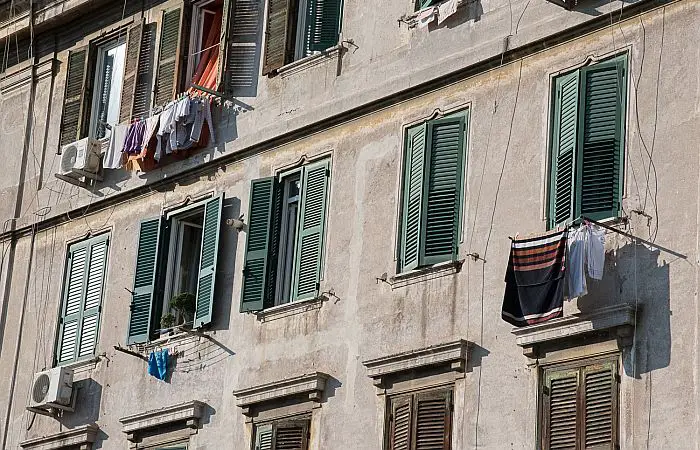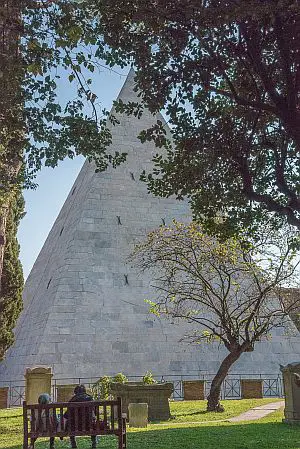A True Roman Neighborhood
Story and photos by Debi Goodwin
A tourist in Rome seeks a neighborhood where she can see the real life of the city.

Don't get me wrong. I love to visit the sights that draw tourists to Rome. To stand in the Pantheon and stare up at the sun entering through the opening of its Roman concrete dome is one of the wonders of the world. To walk over the ancient marble of the Colosseum or buy fruit in Campo de' Fiori are pleasures I'm happy to repeat each time I go to my favorite European city. But there comes a point on any visit to Rome when I crave experiencing the city without the groups who follow flags or crowd around the Trevi Fountain for selfies, some place where the locals outnumber the tourists.
This time I found it in a wonderful neighborhood called Testaccio, an easy walk from the center of Rome, along the Tiber River past the Aventine Hill. Testaccio's history may be less noble than some parts of Rome but it is no less layered. Back in Roman times, ships carrying supplies could go no further up the narrowing river than the spot where the Testaccio neighbourhood now exists. There, crews would offload the heavy goods from the ships; essentials like olive oil were transferred from large terracotta amphorae into smaller containers to distribute in the city. Over the years, they broke enough clay pots to throw in a heap and create the landmark now known as Monte Testaccio.

Later, the neighborhood, far enough away from every important piazza and corso to not offend, became the location of Rome's abattoirs. The area still has its rough edges and apartment blocks built for industrial workers, but it has slowly become hipper, much to the chagrin of locals, so I'm told.
Where the Foreigners Who Die in Rome Go
I discovered Testaccio after a friend suggested I see the cemetery there best known for the graves of English poets Keats and Shelley. Although it's commonly known as The English or Protestant Cemetery, it's actually called The Non-Catholic Cemetery for Foreigners. For centuries it was the only place foreigners who weren't Catholic could be buried; they too, it seems, were kept from the city center.
I found the cemetery on an unassuming street behind walls that hide the lushness of a green, terraced layout and towering stone pines. When I stepped through the gate, I entered one of the most peaceful spots I've encountered in Rome. Other tourists find their way here, but no bus tours are allowed and guided tours are kept small. And there is a hushed tone to the place that seems to make visitors walk more slowly and speak more quietly.

Strolling back and forth along the terraces, I passed classic, Celtic, and Orthodox crosses and the remains of American and English Protestants. There are also Orthodox Russians, Jews, and Muslims from around the world. A plaque on one wall pays tribute to an independent India's first ambassador to Italy whose ashes were sent to the Ganges River in his homeland.
Each gravestone tells the story of a mother, a brother, a child lost, of an ambassador or an American attaché to Rome. It wasn't surprising that given how many artists make their way to the Eternal City that a large number of the monuments reflected the arts. An Argentinian sculptor's grave was marked by a cube resting on a single point. Engravings on plaques read like poems. "Every phrase and every sentence is an end and a beginning. Every poem is an epitaph," read one. I didn't recognize any of the artists buried here other than Shelley and Keats; one gravestone philosophized on the anonymity of most artists: "Pity the men who from the start were martyrs to some dream or art."

No Caravaggio painting or Bernini sculpture bring crowds here. But there was beauty in the many statues of angels and individuals that graced the terraces. One of the most famous statues, called Weeping Angel, was created by the American sculptor William Story for his wife. The angel is bent over the monument, a powerful testament to his grief.
 It was so peaceful here that I sat for a time on a bench by Keats' grave with its stone that reads simply: "This grave contains all that was Mortal of a Young English Poet." Keats' grave is in a flat, more open section of the graveyard, which overlooks one of Testaccio's stranger features, one that made me fonder of this unique neighbourhood. Next to the remains of a Roman wall is a pyramid, a perfect if smaller model of an Egyptian pyramid, evidence of what a man can do when he has a lot of money and an enormous sense of self-worth. The magistrate Gaius Cestius had the pyramid built as his personal tomb, expensive real estate for the glory of a little-known bureaucrat.
It was so peaceful here that I sat for a time on a bench by Keats' grave with its stone that reads simply: "This grave contains all that was Mortal of a Young English Poet." Keats' grave is in a flat, more open section of the graveyard, which overlooks one of Testaccio's stranger features, one that made me fonder of this unique neighbourhood. Next to the remains of a Roman wall is a pyramid, a perfect if smaller model of an Egyptian pyramid, evidence of what a man can do when he has a lot of money and an enormous sense of self-worth. The magistrate Gaius Cestius had the pyramid built as his personal tomb, expensive real estate for the glory of a little-known bureaucrat.
It was only hunger that took me away from the cemetery and the cats that curled up near my feet. I walked back to the main Via Marmorata and the vibrant life of the neighborhood. At an immaculately clean café, long counters displayed breads, pastries and freshly made pizzas. I settled on a cappuccino and two squares of rosemary and potato pizza. Both were delicious and the total bill was less than a single coffee cost in the city center.
Copyright (C) Perceptive Travel 2019. All rights reserved.
- A Vintage Roadtrip: Butterflies, Blues and VW Buses by Lydia Carey
- Retracing the Steps of Lila and Elena in Naples by Michael Shapiro
- Abkhazia: Party Amidst the Ruins by Stephen Bland
- Travel Book Reviews by Susan Griffith
Books from the Author:

Buy Citizens of Nowhere: From Refugee Camp to Canadian Campus at your local bookstore, or get it online here:
Amazon

